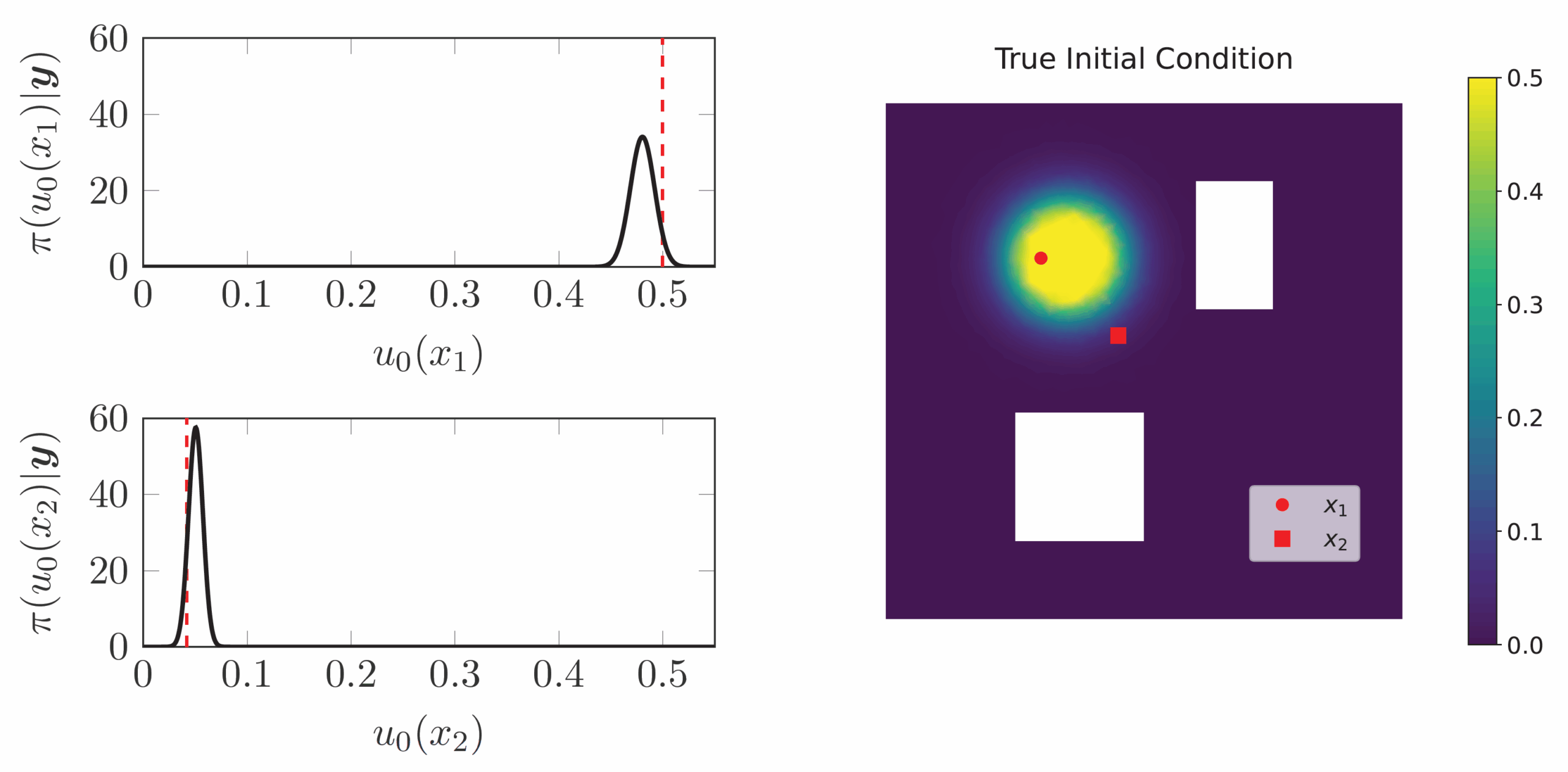Problems inverse

In this inverse problem, researchers use data about a chemical contaminant’s spread through a city (purple area) with buildings (white rectangles) and use that information to model the source (yellow). To study uncertainty, Sonia Reilly calculated the concentration probability curves at two locations (red shapes). Red circle’s initial concentration probability is in the top graph and red square’s is in the lower graph. (Image: Sonia Reilly.)
Much of mathematics involves so-called forward problems. These problems begin with a model of a physical system — say, a ball rolling down an incline plane — and researchers use parameters, such as gravity, to find an answer, such as the ball’s acceleration. Conversely, Sonia Reilly works on inverse problems. She starts with the answer and then estimates the values of the parameters.
Imagine chemical contamination in a town. In an inverse problem, a mathematician starts with final contaminant concentrations at various locations and models where they came from. By estimating the model’s parameters, such as wind speed and direction plus building locations, Reilly could calculate the initial location of the contamination, as shown in the diagram below.
As a doctoral student at New York University’s Courant Institute of Mathematical Sciences, Reilly primarily focuses on uncertainty quantification. As she works with mathematical models, she finds ways to measure how sure she is about the values that she gives them.
Reilly, a Department of Energy Computational Science Graduate Fellowship (DOE CSGF) recipient, uses statistics and probability to explore the theoretical side of uncertainty quantification. In particular, the approach requires probability distributions. “Physical systems often have a ton of parameters, it could be millions,” she says.
Coming up with an equation that describes the parameters’ probability distribution is not that difficult, Reilly says. The challenge arises in making use of it. In theory, she could calculate the area under a probability-distribution curve — on the millions of parameters. But, she says, that “would require an insane amount of computing time.”
Working with Georg Stadler at NYU, she aims to speed up the process with approximations. “I’m currently developing a method for picking out the distribution of just one of these millions of parameters in an approximate way that is still pretty accurate and way faster,” she says.
For example, an applied mathematician might look at how ice is moving across Antarctica. But the friction between the ice and land varies across the continent. “The friction coefficient in every location can be thought of as a separate parameter, so we can end up with arbitrarily many parameters depending on how high of resolution we want our picture of the friction coefficient across Antarctica to be,” Reilly says.
It’s not just ice: Inverse problems pop up nearly everywhere. During her 2023 practicum, for example, Reilly parsed molecules’ shapes from complex image data at Lawrence Berkeley National Laboratory. She and DOE CSGF alumnus (2009-2013) Jeff Donatelli worked with fluctuation X-ray scattering (FXS) images, blurry but data-laden snapshots taken from multiple angles that are meaningless to the naked eye.
She examined the noise in FXS images. “There isn’t a great way to know how much that noise is affecting your answer,” she says. So she worked on an algorithm to see how the noise affects the uncertainty in the molecule’s reconstruction.
One day, Reilly hopes to become a professor and pass along her enthusiasm for math She credits her mother, who homeschooled Reilly and her brother, with inspiring that passion by embellishing math lessons with games and puzzles.
In addition, Reilly notes that she’s had only one female math professor in her eight years of university coursework. She says, “I’m very determined to change that for people after me.”
About the Author
Mike May has worked as a full-time freelancer since 1998, covering topics ranging from biotech and drug discovery to information technology and optics. Before that, he worked for seven years as an associate editor at American Scientist. He earned an M.S. in biological engineering from the University of Connecticut and a Ph.D. in neurobiology and behavior from Cornell University.





You must be logged in to post a comment.